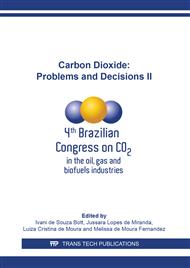[1]
B. Metz, O. Davidson, H. Deconinck, M. Loos, L. Meyer, IPCC special report on carbon dioxide capture and storage, prepared by working group III of the intergovernmental panel on climate change, Cambridge University Press, London, (2005).
Google Scholar
[2]
O.Q.F. Araújo, J.L. de Medeiros, Carbon capture and storage technologies: present scenario and drivers of innovation, CCS techn. 17 (2017) 22-34.
DOI: 10.1016/j.coche.2017.05.004
Google Scholar
[3]
Al-Mamoori, A. Krishnamurthy, A.A. Rownaghi, F. Rezaei, Carbon capture and utilization update, Energy Tech. 5 (2017) 769-961.
DOI: 10.1002/ente.201600747
Google Scholar
[4]
R. Dahowski, J. Dooley, Source/Sink Matching for U.S. Ethanol Plants and Candidate Deep Geologic Carbon Dioxide Storage Formations, Report PNNL-1. US Department of Energy, Springfield, (2008).
DOI: 10.2172/938572
Google Scholar
[5]
P.R.C Merschmann, A.S. Szklo, R. Schaeffer, Technical potential and abatement costs associated with the use of process emissions from sugarcane ethanol distilleries for EOR in offshore fields in Brazil. Int. J. Greenh. Gas Control 52 (2016) 270-292.
DOI: 10.1016/j.ijggc.2016.07.007
Google Scholar
[6]
O.S.M. Dias, T.L. Junqueira, C.E.V. Rossel, R. Maciel Filho, A. Bonomi, Evaluation of process configurations for second generation integrated with first generation bioethanol production from sugarcane. Fuel Proces Tech 109 (2013) 84-89.
DOI: 10.1016/j.fuproc.2012.09.041
Google Scholar
[7]
Information on: https://www.novacana.com/usinas_brasil.
Google Scholar
[8]
M. Kim, D.F. Day, Composition of sugar cane, energy cane, and sweet sorghum suitable for ethanol production at Louisiana sugar mills, J. Ind. Microbiol. Biotechnol. 38 (2011) 803-807.
DOI: 10.1007/s10295-010-0812-8
Google Scholar
[9]
S.T. Mccoy, E.S. Rubin, An engineering-economic model of pipeline transport of CO2 with application to carbon capture and storage. Int. J. Greenh. Gas Control 2 (2008) 219–229.
DOI: 10.1016/s1750-5836(07)00119-3
Google Scholar
[10]
R. Turton, R.C. Baile, W.B. Whiting, J.A. Shaeiwitz, Analysis, Synthesis, and Design of Chemical Processes, third ed., Prentice-Hall, Boston, (2009).
Google Scholar
[11]
Information on: https://www.agrolink.com.br/cotacoes/diversos/cana-de-acucar.
Google Scholar
[12]
Information on: http://143.107.108.83/sigrh/cobranca/perguntas.html.
Google Scholar
[13]
Information on: https://www.cepea.esalq.usp.br/br/indicador/etanol.aspx.
Google Scholar
[14]
Information on: http://agenciabrasil.ebc.com.br/economia.
Google Scholar
[15]
J.L. Medeiros, O.Q.F. Araújo, B.M. Versiani, A model for pipeline transportation of supercritical CO2 for geological storage. J. of Pipeline Eng. 7 (2008) 253-279.
Google Scholar


